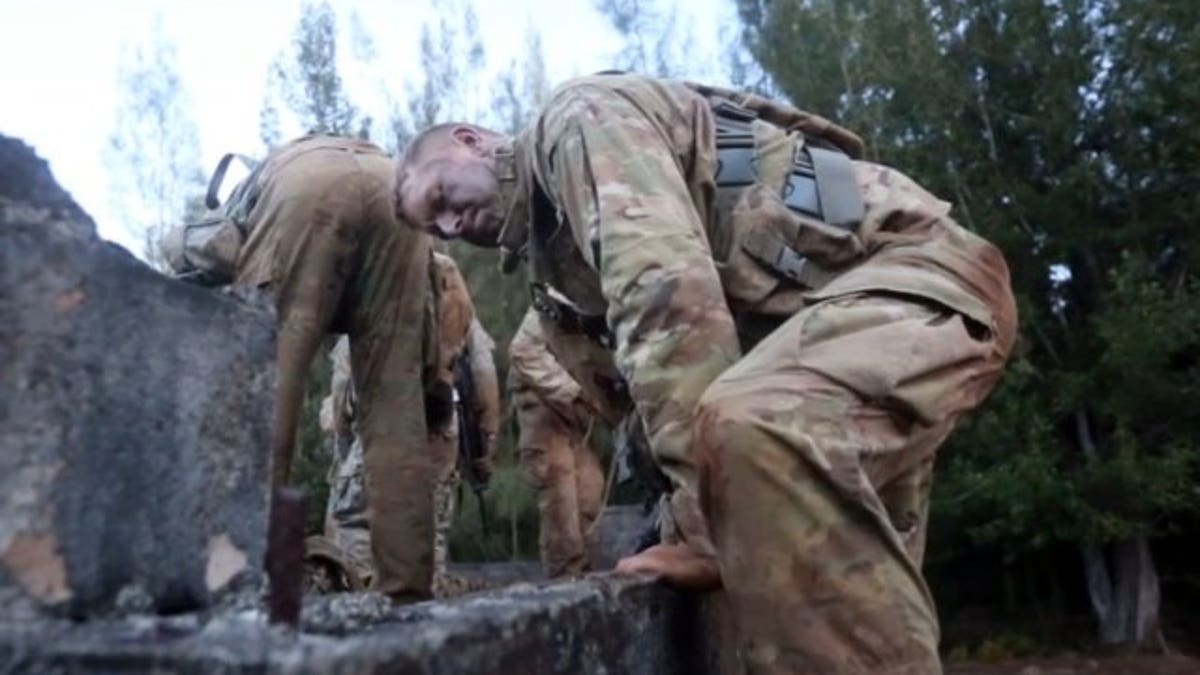
Soldiers with the 25th Infantry Division in Hawaii tackle obstacles in February 2017, while evaluating a new, lighter weight uniform. (U.S. Army photo )
The U.S. Army is developing a lightweight hot weather alternative to the current Army Combat Uniform (ACU) and new jungle boots.
The current ACU weighs about 1.4 pounds and has lots of pockets and multiple layers of fabric. This means that “when it gets wet, it tends to stay wet,” the Army explained in a statement released this week. “And when it's hot out, it tends to keep soldiers hot,” it added.
The answer is the Improved Hot Weather Army Combat Uniform, which has fewer pockets, layers of fabric and Velcro, the Army said. The new uniform also uses a lighter fabric.
THE EVOLUTION OF US MILITARY CAMOUFLAGE: FROM BASIC GREEN AND KHAKI TO DIGITAL PATTERNS AND BEYOND
"You can hold that uniform up with one finger," said Brig. Gen. Brian P. Cummings, Program Executive Officer (PEO) Soldier, out of Fort Belvoir, Virginia, in the statement.
While the current ACU has had a lot of positive feedback, Cummings noted that the likes of shoulder pockets, pen pockets, leg pockets and Velcro swatches for patches require multiple layers of fabric, fastening material and buttons. All of these features hold water “and cost money,” he added.
The jacket from the Improved Hot Weather Army Combat Uniform is on display at PEO Soldier.
HISTORY OF CAMOUFLAGE IN PICTURES
U.S. soldiers in jungle environments will be the first to get their hands on the lightweight uniform, specifically the 25th Infantry Division in Hawaii. Cummings said that the Army eventually wants to make the uniform available to all soldiers.
The Army hopes that the new uniform will be available within a year. Cummings explained, however, that the new uniform’s fabric may prove more susceptible to wrinkling after washing. This could be fixed with the application of an anti-wrinkling treatment, although that would depend on whether the treatment interfered with the uniform’s ability to wick away water.
The new uniform’s flame-resistant capability also needs to be considered, according to Cummings.
In addition to the new uniform, the Army is also working on a new jungle boot. Last month, soldiers in the 25th Infantry Division in Hawaii received 30,000 pairs of the new design to evaluate.
EVOLUTION OF COMBAT BOOTS: FROM BOOTEES TO MODERN TACTICAL BOOTS
Feedback on the boots has been positive, but Cummings said that soldiers want a boot that is lighter and softer. They have also requested thinner soles.
The next set of samples, Cummings said, will be "a lot more pliable. And able to serve the soldier well. But instead of lasting five years, they [will] last two years."
The newer boots will also go through evaluation with soldiers and share features with the boots currently being tested. These capabilities include puncture resistance, more drainage holes, the ability to wick away water, the ability to push water and mud off the soles, speed laces and lower profile heels so as not to catch on vines on the jungle floor, according to the Army’s statement.
HISTORY OF COMBAT BOOTS IN PICTURES
Last year, the U.S. Navy announced that it is getting rid of its blue camouflage ‘blueberries’ uniform.
